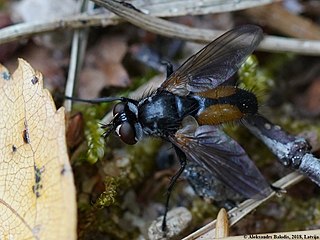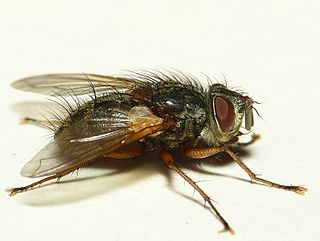
Sturmia is a genus of flies in the family Tachinidae.
Hebia flavipes is a species of fly in the family Tachinidae.

Gymnosoma is a genus of flies in the family Tachinidae.

Hemyda is a genus of flies in the family Tachinidae.
Neaera is a genus of flies in the family Tachinidae.

Lydella is a genus of flies in the family Tachinidae. Lydella thompsoni can be used in the UK for the biological control of the European corn borer.
Microsoma exiguum is a species of fly in the family Tachinidae. It is a parasitoid of Sitona.

Blondelia nigripes is a species of fly in the family Tachinidae.
Clemelis pullata is a species of fly in the family Tachinidae. This family consists of dipteran tachina flies, which are protelean parasitoids of arthropods.

Exorista larvarum is a Palaearctic species of fly in the family Tachinidae.

Compsilura concinnata is a parasitoid native to Europe that was introduced to North America in 1906 to control invasive populations of the exotic gypsy moth , which primarily infests forests. The fly is an endoparasitoid of insect larvae that lives within its host for most of its life. The parasitoid eventually kills the host and occasionally eats it. It attacks over 200 host species, mainly insects from the orders Coleoptera, Lepidoptera, and Hymenoptera.
Bithia spreta is a European species of fly in the family Tachinidae.

Solieria pacifica is a European species of fly in the family Tachinidae.
Macquartia praefica is a European species of fly in the family Tachinidae.
Smidtia conspersa is a species of fly in the family Tachinidae.

Nemorilla floralis is a species of tachinid fly.
Periscepsia carbonaria is a species of fly in the family Tachinidae. Hosts are of the moth genus Agrotis.
Phorinia aurifrons is a species of bristle fly in the family Tachinidae.

Phryno vetula is a species of bristle fly in the family Tachinidae.
Billaea fortis is a species of fly in the family Tachinidae.










